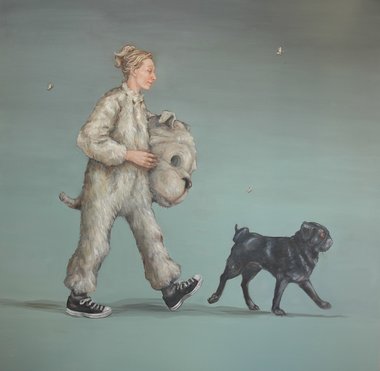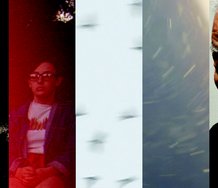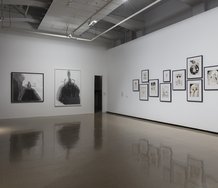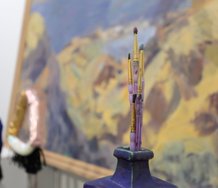Mark Amery – 11 June, 2011
The entire exhibition could be considered as artist self-portrait, the keenly focussed, questioning eye of the animal, and the cock of their heads, Braithwaite's own as she questions her own feelings about being on display and following her own creative path.
Wellington
Joanna Braithwaite
Significant Others
Curated by Jenny Bornholdt and Greg O’Brien
2 June - 7 August 2011
The typical tension in any national portrait gallery is between exhibiting pictures of personages and great art. As we all know, one doesn’t necessarily beget the other.
In an age when we are surrounded in an all-pervading media by stage-managed portraits, I like it when a portrait gallery really tests out how great art and human complexity can both still be found in a portrait. Often those pictures are not of well-known subjects, and stretch portrayal in interesting ways.
One of the Portrait Gallery’s strengths in its home in Shed 11 on Wellington’ waterfront has been its openness to proposals from outside curators, and some strong exhibitions have resulted. Paul McNamara’s Kin last year was a good example. Gregory O’Brien and Jenny Bornholdt’s Significant Others can be added to the list.
It’s a neat twist for the Portrait Gallery to be exhibiting Joanna Braithwaite paintings. In Braithwaite’s portraits animals and birds heighten the mixed emotions packed around human portrayal and preening, and the uneasiness of societal pecking orders.
Clearly an animal lover, Braithwaite’s depictions of pets here, employing the theatrical arsenal of the portraitist - studio backdrop, props and paintbrush - question the underlying assertion that “all animals are equal, but some are more equal than others” that our treatment of our fellow beasts suggests
Bornholdt and O’Brien bring some smart focus to Braithwaite’s examination of the conventions of portraiture and the historical portrayal of animals over the years. This is a survey of a particular strain of her practice: both her use of historical precedents - a playful catalogue of different approaches to framing and positioning of both people and animals - and the contemporary vitality that on occasion she shows painting can have in the expressive slippage between representation and abstraction.
In Braithwaite’s best work the portrait makes naked the complexity of human behaviour at the very point when we are trying to cover it up with costume. It never ceases to amaze me how poignant we find it is to dress up animals as humans. How expressive we find animals of human personality types. Take in this exhibition the rooster in a punk leather jacket, or the poodle in a beret.
The exhibition reminded me immediately of the home family photo display on mantelpiece or wall. How these can be read collectively as a self-portrait. Here the cherished pets, usually at people’s feet, have taken their master’s place. In the case of several self-portraits, birds and animals have become Braithwaite’s actual clothes, each creature acting out some element of her personality. The curators use the term ‘Significant Others’ here to denote a family’s beloved pets rather than more typically an individual’s love or sexual partner.
The entire exhibition could be considered as artist self-portrait, the keenly focussed, questioning eye of the animal, and the cock of their heads, Braithwaite’s own as she questions her own feelings about being on display and following her own creative path. Every expression across the gallery of pride, injury, freedom or self-doubt is Braithwaite’s and ours by extension.
The curators frame this by opening the exhibition with a couple of early self-portraits from the 1980s (made interesting really only by this context), and these are followed early on by several recent large paintings featuring the artist with a host of guineapigs, dogs or birds.
In Chook Chook Chook Braithwaite is naked but for a flock of prized and preened chickens. The artist squarely faces the viewer, hands on hips, as if this were an Annie Leibovitz Vanity Fair fantasy, yet with the near-winking eye of a Velazquez self-portrait.
Artist self-portraits abound. A peacock wears a hat that recalls Edith Sitwell (Sitwell’s work referenced in its title Still Falls the Rain), a dog a hat (ironically of fur) that recalls in pose and the paintstrokes of the fur a Van Gogh self-portrait. In this way Braithwaite booby-traps her paintings with cultural references to touch off aspects of the human spirit. Humour is deployed to display vanity with a question mark - like the bird that tries to make off with a lock of her hair to build a nest as she tries to strike a pose.
In Walk the Walk the artist walks behind her pug dog, its eyes focussed forward, her’s downwards, unsure. She is wearing a dog costume but has taken off the head. As an artist following her own singular path it seems to ask ‘should I follow the same line those others do?’ and ‘what can I learn from following the instincts of this animal I love so much?’
Braithwaite’s work is notable for its smart use of humour and theatre to unlock emotion as well as speak of the function of art in history. The tensions causes by the awkwardness of being on display, with a confliction of emotions and a subtly expressive use of paint mark out her finest work.
In Performance Anxiety, for example, two guinea pigs on hind legs cling together before red theatre curtains, at once defiant and scared, their little fists punching out of the patchy paintwork. Braithwaite is brilliant at expressing emotion tenderly through facial expression and gesture just as her subjects are being put under the public spotlight.
Sometimes her use of paint can seem quite flat and unanimated, with large dead fields of background colour. Indeed the great set of small works here reveal her strength as a cartoonist. At her best the whole canvas plays a part in the theatre, paint giving her subjects a charged fluidity to be at once of the present and past, human and animal, comic and tragic.
One general criticism. The exhibition feels like its been filled out to fill the space. A smaller tighter show might have been more satisfying. There is an overabundance of recent work of a similar ilk of mixed success - more usual of an annual dealer gallery show (it saves the dealers considerable work in promoting it) and the likes of Bird Watch and Foul Relatives (puns excepted) add nothing that other works don’t do considerably better. A trio of 2009 works Long Shot, Flight Path and Heaven on Earth are among quite a few works here that don’t feel vital enough to the theme to have warranted inclusion.
That said, it is the curators’ thorough thinking work across painting found through Braithwaite’s dealers and private collections that makes this a significant exhibition of Braithwaite’s work. One much warranted in Wellington where we missed out on the strong 2005 Christchurch and Dunedin survey show Wonderland.
Mark Amery



 Two Rooms presents a program of residencies and projects
Two Rooms presents a program of residencies and projects Advertising in this column
Advertising in this column



This Discussion has 0 comments.
Comment
Participate
Register to Participate.
Sign in
Sign in to an existing account.